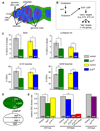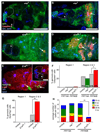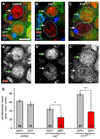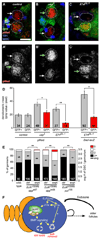The steroid hormone ecdysone functions with intrinsic chromatin remodeling factors to control female germline stem cells in Drosophila
- PMID: 21040900
- PMCID: PMC3292427
- DOI: 10.1016/j.stem.2010.10.001
The steroid hormone ecdysone functions with intrinsic chromatin remodeling factors to control female germline stem cells in Drosophila
Abstract
Steroid hormones are known systemic regulators of multiple normal and cancerous tissues; however, whether or how they impact the fate and function of adult stem cells is unclear. In the Drosophila ovary, insulin signals modulate the proliferation and self-renewal of germline stem cells (GSCs), yet despite evidence that additional systemic factors control GSC activity, these have remained largely unknown. Here, we report that ecdysone, a steroid hormone structurally related to mammalian sex steroids, directly regulates adult GSC proliferation and self-renewal independently of insulin signaling. Ecdysone controls GSCs through a functional interaction with the chromatin remodeling factors ISWI, an intrinsic epigenetic factor required for GSC fate and activity, and Nurf301, the largest subunit of the ISWI-containing NURF chromatin remodeling complex. Our findings support a link between systemic steroid hormones and the intrinsic chromatin remodeling machinery as a potential mechanism to promote broad transcriptional programs required for adult stem cell self-renewal.
Copyright © 2010 Elsevier Inc. All rights reserved.
Conflict of interest statement
The authors declare no competing conflicts of interest.
Figures






Similar articles
-
Cyclin E controls Drosophila female germline stem cell maintenance independently of its role in proliferation by modulating responsiveness to niche signals.Development. 2013 Feb 1;140(3):530-40. doi: 10.1242/dev.088583. Development. 2013. PMID: 23293285 Free PMC article.
-
Coordinated regulation of niche and stem cell precursors by hormonal signaling.PLoS Biol. 2011 Nov;9(11):e1001202. doi: 10.1371/journal.pbio.1001202. Epub 2011 Nov 22. PLoS Biol. 2011. PMID: 22131903 Free PMC article.
-
Lissencephaly-1 controls germline stem cell self-renewal through modulating bone morphogenetic protein signaling and niche adhesion.Proc Natl Acad Sci U S A. 2010 Nov 16;107(46):19939-44. doi: 10.1073/pnas.1008606107. Epub 2010 Nov 1. Proc Natl Acad Sci U S A. 2010. PMID: 21041636 Free PMC article.
-
Role of Chromatin Modifications in Drosophila Germline Stem Cell Differentiation.Results Probl Cell Differ. 2017;59:1-30. doi: 10.1007/978-3-319-44820-6_1. Results Probl Cell Differ. 2017. PMID: 28247044 Review.
-
Restricting self-renewal signals within the stem cell niche: multiple levels of control.Curr Opin Genet Dev. 2011 Dec;21(6):684-9. doi: 10.1016/j.gde.2011.07.008. Epub 2011 Aug 19. Curr Opin Genet Dev. 2011. PMID: 21862315 Review.
Cited by
-
Finding a niche: studies from the Drosophila ovary.Stem Cell Res Ther. 2011 Nov 25;2(6):45. doi: 10.1186/scrt86. Stem Cell Res Ther. 2011. PMID: 22117545 Free PMC article. Review.
-
Epigenetic regulation of germ cells-remember or forget?Curr Opin Genet Dev. 2015 Apr;31:20-7. doi: 10.1016/j.gde.2015.04.003. Epub 2015 May 1. Curr Opin Genet Dev. 2015. PMID: 25930104 Free PMC article. Review.
-
A role for tuned levels of nucleosome remodeler subunit ACF1 during Drosophila oogenesis.Dev Biol. 2016 Mar 15;411(2):217-230. doi: 10.1016/j.ydbio.2016.01.039. Epub 2016 Feb 2. Dev Biol. 2016. PMID: 26851213 Free PMC article.
-
Mcm10 is required for oogenesis and early embryogenesis in Drosophila.Mech Dev. 2015 Nov;138 Pt 3:291-9. doi: 10.1016/j.mod.2015.09.002. Epub 2015 Sep 12. Mech Dev. 2015. PMID: 26369283 Free PMC article.
-
Reproduction, fat metabolism, and life span: what is the connection?Cell Metab. 2013 Jan 8;17(1):10-9. doi: 10.1016/j.cmet.2012.12.003. Cell Metab. 2013. PMID: 23312280 Free PMC article. Review.
References
-
- Asselin-Labat ML, Vaillant F, Sheridan JM, Pal B, Wu D, Simpson ER, Yasuda H, Smyth GK, Martin TJ, Lindeman GJ, et al. Control of mammary stem cell function by steroid hormone signalling. Nature. 2010;465:798–802. - PubMed
-
- Bai J, Uehara Y, Montell DJ. Regulation of invasive cell behavior by taiman, a Drosophila protein related to AIB1, a steroid receptor coactivator amplified in breast cancer. Cell. 2000;103:1047–1058. - PubMed
-
- Bialecki M, Shilton A, Fichtenberg C, Segraves WA, Thummel CS. Loss of the ecdysteroid-inducible E75A orphan nuclear receptor uncouples molting from metamorphosis in Drosophila. Dev Cell. 2002;3:209–220. - PubMed
Publication types
MeSH terms
Substances
Grants and funding
LinkOut - more resources
Full Text Sources
Medical
Molecular Biology Databases
Research Materials

